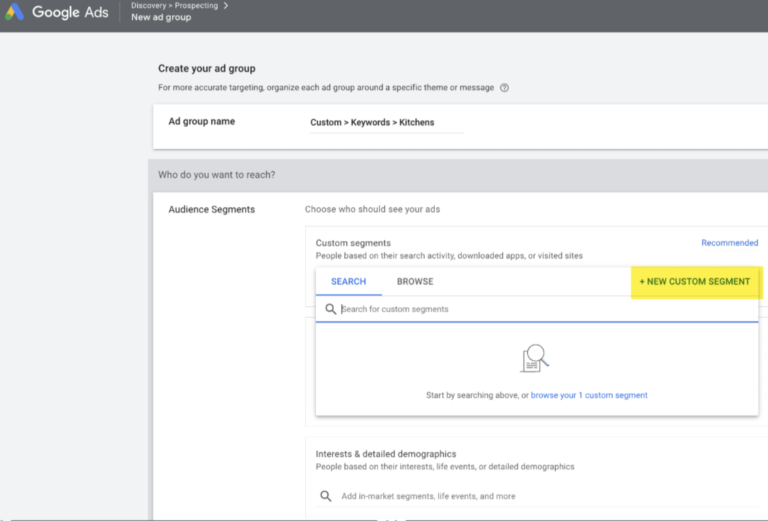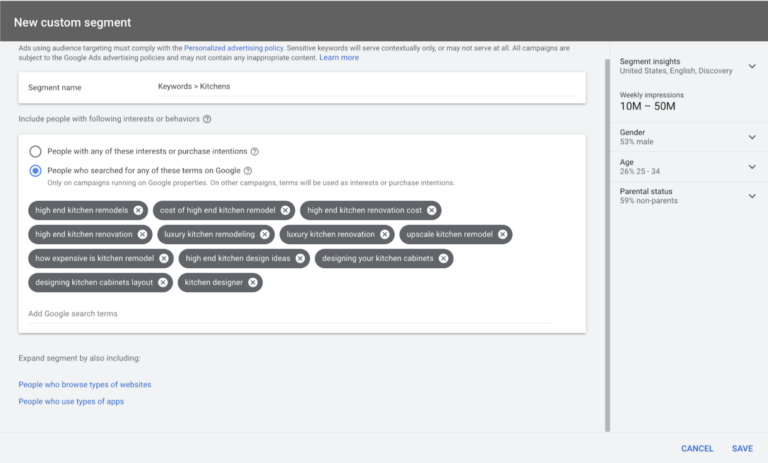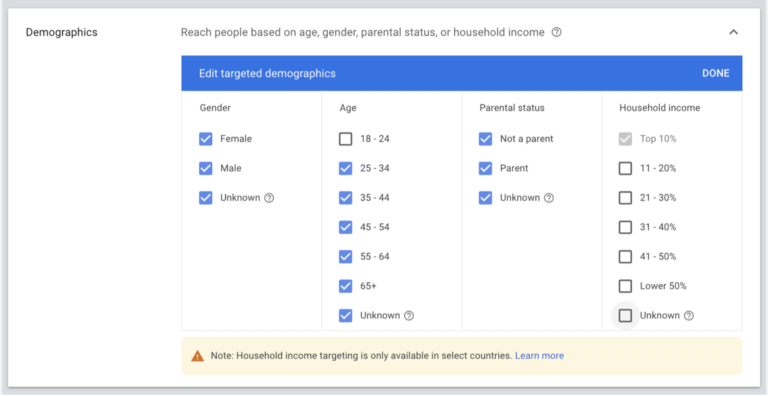When Google Discovery campaigns first came on the scene in 2019, I was skeptical they would amount to much.
Their available inventory across Gmail, YouTube, and the Discovery feed seemed too small to amount to anything of significance for most advertisers.
As Google has iterated and expanded, though, I’ve changed my tune.
While not as scalable as standard Google Display or YouTube campaigns, I now know the value that these campaigns can have, and work to incorporate them for most of the accounts I am involved in.
So – what does it take to find success with Google Discovery Ads?
The foundation is all about serving the right message, to the right person, at the right time.
Lucky for Discovery users, that ad unit has several advantages over standard Google Display campaigns (and search, too).
Here’s what we’ll cover in this article:
- Discovery’s #1 Targeting Differentiator.
- Layering Targeting in Discovery Campaigns.
- Discovery + Retargeting.
- Optimized Targeting.
- Discovery Ad 101s + Dos and Don’ts.
Discovery’s #1 Differentiator: Targeting
With its ability to serve impressions at the moment of intent (the search), Paid search is generally the most efficient Google advertising product.
With Google Display, you can run ads to retargeting and similar to audiences based on a pool of past paid search clickers, but you cannot explicitly target a cohort of people who searched for specific terms before.
With Discovery, you can.
Within Discovery campaigns, Custom Segments allow you to explicitly target based on Google search activity.
Never before have you been able to create an ad group that only targets searchers of select keywords within YouTube, Gmail, and the Discovery feed.
This is really powerful.
This targeting unlocks a wedge intent stage between display prospecting and paid search unique to Google Ads.
Custom Segments: How To Set Them Up
Because Google owns all properties (Discovery, Gmail, YouTube) that Discovery Ads show on, you can ensure that keyword targeting serves impressions to past searches of your keyword variants.
Setup is easy.
When creating your ad group, select New Custom Segment.
 Screenshot taken by author from Google Ads, March 2022
Screenshot taken by author from Google Ads, March 2022From there, select the People who searched for any of these terms on Google radio button, and input your keywords.
 Screenshot taken by author from Google Ads, March 2022
Screenshot taken by author from Google Ads, March 2022By doing this, you will serve ads to anyone who searches for these terms on Google.
One note.
Assume these keywords are treated as broad match.
Nonetheless, this targeting option is Discovery’s differentiator – and it is a good one.
Pro Tip: Segment this targeting out into its own ad groups/campaigns to ensure you have the control you need on things like spend, budget, bid strategy, etc.
You will likely want to maximize reach and frequency to this audience subset and differentiate the experience from your other display campaigns.
Hone In By Layering Targeting Criteria
Like Google Display, Discovery supports affinity, in-market, life event, and demographic targeting options.
And like Google Display, these targeting options can layer on top of each other.
One of my favorite combinations is Custom Audiences + Targeted demographics, given the personalization opportunities with imagery in the responsive display ad units.
For example, if I’m targeting high net worth individuals, I could layer on the top 10% of HHI via Demographics targeting.
 Screenshot taken by author from Google Ads, March 2022
Screenshot taken by author from Google Ads, March 2022Pro Tip: With Discovery, you can serve “display” ads to people interested in your competitors.
Use keywords, key competitor pages (login, pricing), and apps to digitally surround competitor prospects and customers with a personalized pre/post experience.
The visual element of Discovery makes it a great tactic for these conquesting campaigns.
Discovery Retargeting Is A Must
If you run standard display retargeting campaigns, Discovery retargeting campaigns are a no-brainer.
Discovery offers inventory not available through standard display.
Given that retargeting campaigns often hold the best ROI for advertisers, maximizing impressions as much as possible makes sense.
In addition to the extra inventory, Discovery’s 4:5 aspect ratio ads and carousels are unique to the campaign type. They provide an opportunity for a differentiated experience compared to standard display.
Pro Tip: Use Customer Match lists to target lead ad customer lists with ungated brand content relevant to them.
People engaging with the Discovery feed are looking for content to consume.
If you have content you want to push out to a high-value first-party data list, this is a great way to do it.
This poses an excellent opportunity for you to showcase your expertise, communicate a value proposition, explain a feature, share a past client story, talk through the onboarding process, etc.
Things To Avoid: Optimized Targeting
Optimized Targeting, previously known as Audience Expansion, is a feature Google enables by default when setting up new campaigns and ad groups.
Google will tell you that they identify signals of likely converters to give you more leads at a similar CPL as your non-“optimized” initiatives.
The collective experience of colleagues and coworkers has been that there is very little case to keep this setting enabled.
Most advertisers should avoid it.
It provides very little visibility or control with targeting, meaning limited optimization opportunity.
With retargeting campaigns, it should be avoided 100% of the time, given that it changes the campaign to target beyond reengagement.
Discovery Ad 101 + Dos and Don’ts
Discovery’s targeting is unique, but ad units also offer up some unique opportunities.
Like Display, Discovery Ads are responsive. You give it a series of image and text inputs, and the algorithms determine the optimal ad to serve, depending on the user’s demographics and behaviors.
While they are nearly identical to Google Display responsive display ads, there are a few differences between those and Discovery ads.
Mainly:
- Discovery ads do not support video.
- Discovery ads do offer a responsive carousel ad format.
- Discovery ads do offer a mobile, newsfeed friendly 4:5 aspect ratio.
Foundational principles of display ads apply to Discovery as well. It all comes down to personalizing the pre/post click experience with content of interest and/or value and capitalizing on the unique features that ad type offers.
Discovery Ad Dos
- Do utilize the 4:5 aspect ratio. Google’s tool can help, or you can hire a freelancer to resize your existing banner for less than a dollar (when done in batch).
- Do maximize the images, headlines, and descriptions used for each ad. The more you can give Google to test, the better your ad strength will be.
- Do utilize creative learnings from your social channels. The mindset of the Discovery ad viewer is very similar to that of someone scrolling social feeds.
- Do use images with people in them. They typically drive better CTAs than images without people.
- Do consider tying a lead gen form to your discovery ad – especially for warm audiences. Extra credit if you integrate your CRM to automate lead flow.
- Do monitor your asset level reports for indicators your ad text and image components are resonating.
Discovery Ad Don’ts
- Don’t imply interactivity (e.g. Add a CTA button). Google is more strict on that compared to standard display campaigns
- Don’t use much overlay text in your images. It leads to lower CTRs on average. It also leads to sub-optimally formatted ad units for certain inventory
- Don’t overuse low-funnel KPIs with cold audiences. Like other display and social tactics, you’ll generally want to warm your audience up before offering up a low funnel call-to-action
- Don’t utilize Discovery campaigns before you have conversion tracking set up. Bid strategies for Discovery all utilize conversion data.
Conclusion
Discovery Ads are a new(ish) format to Google Ads that is becoming increasingly important to utilize as privacy takes center stage.
They offer several unique advantages over other ad types across Google Ads and beyond, including search keyword-level targeting.
By keeping marketing best practices at the top of your mind during campaign setup and optimization, Discovery will become a staple component of your digital marketing efforts.
More resources:
- Google Ads Introduces New Recommendations For Discovery Campaigns
- Optimizing for Google Discover: Key Areas to Focus On
- Perfectly Optimized Content From Start To Finish
Featured Image: art GALA/Shutterstock




